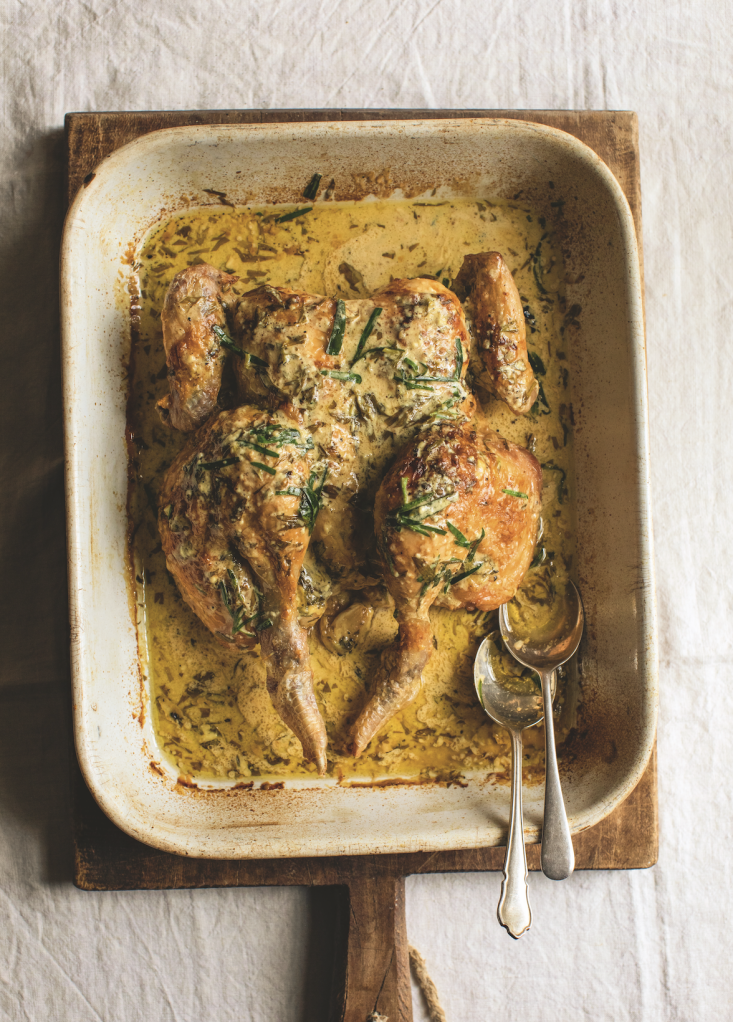“Winter is the price you pay for living in the countryside,” says Instagram sensation Julius Roberts in the first chapter of his deeply seasonal debut cookbook, The Farm Table. Even in winter, though, life looks like a rural fantasy on the cook, farmer, and gardener’s English smallholding (a British term for farmstead).
If you’re not familiar with Roberts, his story is redolent of our times. Having grown up in London, and trained in the intense kitchen of Noble Rot (a London restaurant so consistently lauded that it features on many food writers and chefs’ lists of favorite places to eat), he went searching for a life more in harmony with the land. That quest first took him east to the Suffolk countryside, where he cut his teeth as a homesteader, and then three years ago to a family smallholding in the far more lush hills of Dorset.

He started out with four rare breed pigs. They were followed by chickens, a veg plot, bees, 40 goats, and a 100-strong flock of Hebridean sheep—all cohabiting on a bucolic patch of land that has been chemical-free for 30 years, all recorded on his hugely popular Instagram account, alongside quick-paced cooking on a little stove in the greenhouse or from the farmhouse kitchen.
Photography by Elena Heatherwick, from The Farm Table.


As you’d expect, his debut book channels all of the beauty of his smallholding—especially the moments captured through the seasons on the farm—as he launches into around 100 recipes, beginning with the seductive food of the coldest months. These dishes are familiar (Roberts readily admits that these are the things he and his family have cooked forever), but they chime right now for their simplicity and seasonality; it’s the kind of food that you want to cook right away.


Though Roberts isn’t anti-meat, he is passionate about buying the best quality ingredients possible. His lightbulb moment came while cheffing in London, when he wondered, “Why are we so disconnected from where our food comes from and the animals in our care?”


Each season’s recipes channel their essence —the earthiness and abundance of autumn, the verdant zinginess of spring (baked fish with herbs, lemon and asparagus or a courgette frittata with goat cheese, lemon, mint). There are tarts and pies, soups and stews, and many warming dishes. (Baked vacherin with Swiss chard and pink fir apple potatoes? Yes please). None of it feels fussy or time consuming, but with a farm to run, why would it?

This writer has already become obsessed with Roberts’ plum jam, which uses half the amount of sugar of a typical recipe and adds aromatic fig leaves into the mix. Elsewhere, as anyone who has pored over the farmer’s videos will know, you may want to adjust the amount of extra virgin olive oil being generously poured into many dishes.But that is the point of this kind of cooking—it’s easily adjustable to your own tastes. Before you decide to cut back on the fat, though, perhaps give the following recipe a go.
Tarragon Roast Chicken Recipe
*Excerpted from The Farm Table
Ingredients
Serves 5
- 1 organic chicken
- 3 tbsp olive oil
- 1 whole head of garlic
- 250ml quality double cream
- a 20g bunch of fresh tarragon, stalks removed, roughly chopped
- 1 large heaped tbsp Dijon mustard
- a glass of dry white wine

Method
Preheat your oven to 220°C fan [convection] and start by spatchcocking the chicken. To do this, turn it over and cut along one side of the spine from the tail to the neck. Then turn it over, open out the two sides and press down hard to flatten it. Your butcher will gladly do this for you. Lay the chicken in a large, high-sided roasting tray, season generously with salt on both sides and leave for an hour at room temperature so it loses the chill of the fridge.
When ready, generously drizzle the skin with olive oil and work it into all the nooks and crannies. Smash the head of garlic and hide the cloves underneath the chicken, then roast in the oven for 20–30 minutes, until the skin begins
to turn golden brown.
Meanwhile, mix the cream, tarragon and mustard in a bowl and season well with salt and pepper. After 20–30 minutes, turn the oven down to 140°C fan, take out the chicken and pour a generous glass of white wine into the tray. Then pour the tarragon cream all over the chicken and place back in the oven for 30–40 minutes until it’s ready. To judge when it’s cooked, I check the deepest part of the thigh with a temperature probe, looking for 65–70°C. If you don’t have one, prod this point with a skewer and ensure the juices run clear. At this point, remove from the oven and leave to rest for 15 minutes, covered loosely with a bit of foil. Carve straight into the tray and serve as you like, with lots of the sauce, garlic and a zingy green salad.
Julius Roberts’ The Farm Table is in bookstores now in the UK; the book launches in the US February 13, 2024.
See also:
- Celebrity Farmer: Meet Jean-Martin Fortier, Canada’s ‘Six Figure’ Organic Micro-Gardener
- 11 Garden Ideas to Steal from Hipster Homesteaders
- Homestead Act: A Family Trades City Life for a Farm on Martha’s Vineyard









Have a Question or Comment About This Post?
Join the conversation